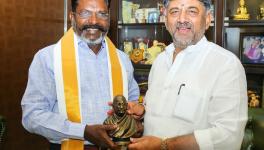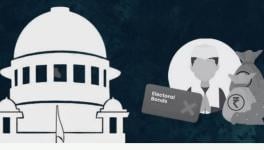Congress and BJP: Both parties in Doldrums
It is very likely, that if the trends indicated by the Assembly elections in recent years follow the logical course, the Congress and the Bharatiya Janata Party could together constitute just a minority in the Lok Sabha in the next general elections.
Both parties are in the doldrums, with a weak leadership and a clear inability to beef up their organization to a point where they become acceptable to the people. Gadkari at the helm of BJP affairs is not particularly convincing, and the ill health of Congress president Sonia Gandhi (neither confirmed nor denied) and the immaturity of her son Rahul Gandhi certainly do not add to the confidence of the waning Congress party. In fact the media in its fascination for the two national parties has turned them into paper tigers, with more space being devoted to them in the so called national press than by the voters in the ballot box.
Judging from the party meetings, neither have the BJP nor the Congress have learnt any lessons from the hustings, nor have they accepted the need to strengthen and reform their respective organizations from within. The same old wine being pushed into bottles that too are now decaying is certainly a recipe for disaster, and the factionalism within is also not going to help either party when they go in for the general elections in 2014. Spiraling prices as households struggle across India to make ends meet is going to spell the end of the UPA’s growth story, and perhaps even its tenure in power. The BJP’s lack of focus and the absence of a concrete agenda, apart from spreading communalism, is not going to help it retain old voters or gain new support.
The era thus, belongs to the regional parties regardless of elite Delhi’s reservations and dislike for the state parties and leaders. And while it is true that despite the two plus decades in coalition governments at the centre, the regional parties have still to show visible signs of maturity, it is also true that many of them have established decisive support bases in their states and are here on the Indian political scene to stay.
It is strange how Delhi’s elite does not hesitate to dismiss the regional leaders with a “oh dear what is going to happen to India now” while it continues to embrace the non-performing, faction ridden BJP and Congress as worthwhile options. This despite the fact that both are no longer committed to pro-people economic policies, the democratic space or to secularism as a non-negotiable doctrine. So the corruption of a Mayawati invites more ire than the not so visible corruption of a BJP or Congress top leader, almost as if to be corrupt one should also be sophisticated. Then it is forgivable, and even acceptable.
Meanwhile unsophisticated India has been exercising its preferences, and very visibly. It has continued to repose faith through elections in the DMK, AIADMK, Samajwadi party, Bahujan Samaj Party, Biju Janata Dal, Akali Dal, Janata Dal(U), National Conference, Peoples Democratic Party, Asom Gana Parishad, and so on and so forth. One is not mentioning the Trinamool Congress here as this could be just a five year wonder, or the Telengana Rashtriya Samiti as it is still to prove itself. But the point is that regional alternatives are flourishing, and as the Congress and the BJP blunder the people have no hesitation in filling the vacuum with the state parties. An Akhilesh Yadav seems more acceptable and real to them than a Rahul Gandhi, and they thus, vote accordingly. For the party that is visible to them, and for a leader they trust to be at their side at least some of the time and more than those sitting in Delhi.
So Delhi’s elite will probably have to prepare itself for a coalition government in 2014 with the regional parties more control than now. But a word of caution is necessary, as the people’s patience is running out with the regional alternatives as well with many of them likely to hit the dust as the electoral caravan rolls on. For instance, the Telugu Desam is finding it difficult to get back the lost confidence of the electorate after being quite popular in Andhra Pradesh for a while. Similarly Karunanidhi and his family and of course, the DMK will find it difficult to regain lost trust with corruption having eaten into the power structure of this particular Tamil Nadu party. The Akali Dal will continue to hold its own, as will the AIADMK , the BSP and the AGP.
But the two chief ministers whose unpopularity is undiminished, in fact has grown over the years, are Naveen Patnaik of the BJD in Orissa, and Nitish Kumar of the JD(U) in Bihar. The strange little coup attempt by a former confidante of Patnaik failed to even take off. Instead even known dissidents came out with a statement supporting the Chief Minister. Similarly Nitish Kumar seems almost invincible. And the reason for their success lies in their accessibility to the party and the people, firm governance, and levels of accountability not seen in other states and from other leaders. The people have applauded their work by staying with them.
This lesson is spreading and most political parties in the states are coming around to the view that they can stay in power, or at least as a strong Opposition, if they strengthen their ties with the people through good governance. The Indian electorate is extremely tolerant and likes to give an exceptionally long rope to the political leaders. And if like Patnaik and Kumar, others show that they are at least trying hard to develop their states and unite the people through justice and social equity there is no reason for the rope to be pulled back, and as happened in many cases, snapped.
Coalition governments come with some cons inherent in the too many cooks formula. But a common agenda and plan of action strictly adhered to will help overcome many of these hurdles with then the pro’s outweighing the cons in the final analysis. The one big pro- is the representative character of a coalition government that makes it sensitive and answerable to the states, and not just the centre, of India. It also guards the people against a vicious two party system the character of which is evident in the BJP and the Congress.
As for the Left that is substance for another column. Suffice it to say that the ground situation in India seems natural and conducive for a Left revival, but despite this the Communist parties have restricted themselves to just three states. The local elections in Shimla have been positive for the Left, but there is dire need to build on this. For this the organizations have to be made responsive by getting rid of much of the dead wood collected over long decades in power, and energizing the party in the states with the youth power that remains an asset for the Left. Unlike Delhi’s elite this columnist remains a firm advocate of the third front that might not be visible right now, but requires a good chef to recognise the ingredients and get these together into a viable and functioning entity.
Get the latest reports & analysis with people's perspective on Protests, movements & deep analytical videos, discussions of the current affairs in your Telegram app. Subscribe to NewsClick's Telegram channel & get Real-Time updates on stories, as they get published on our website.
























